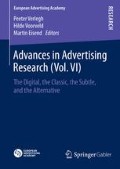Abstract
When you order a drink at your local juice bar, you notice that the flexing part of the straw has a picture of a woman who is holding her hands up. As you flex the straw, the woman bends backwards. This is a clever ad for a yoga center that also presents the link to its website. To what extent do consumers talk about such creative advertising? And what do they say about it? Do they mention the brand name, or focus only on the clever execution? Research has shown that creative media advertising, of which the drinking straw is an example, may have a positive effect on consumers’ attitudes and brand recall (Dahlén et al. 2009). But do creative media also lead to an increase in word of mouth? And to what extent is this word of mouth linked to the brand itself?
Access this chapter
Tax calculation will be finalised at checkout
Purchases are for personal use only
Preview
Unable to display preview. Download preview PDF.
References
Ang, S. H., and S. Y. M. Low (2000), “Exploring the dimensions of ad creativity,” in: Psychology and Marketing, 17 (10), 835–854.
Berger, J., and K. L. Milkman (2012), “What makes online content viral?” in: Journal of Marketing Research, 49 (2), 192–205.
Berlyne, D. E. (1950), “Novelty and curiosity as determinants of exploratory behavior,” in: British Journal of Psychology: General Section, 41 (1/2), 68–80.
Cacioppo, J. T., von Hippel, W. and J. M. Ernst (1997), “Mapping cognitive structures and processes through verbal content: The thought-listing technique,” in: Journal of Consulting and Clinical Psychology, 65 (6), 928–940.
Dahlén, M. (2005), “The medium as a contextual cue: Effects of creative media choice,” in: Journal of Advertising, 34 (3), 89–98.
Dahlén, M., and M. Edenius (2007), “When is advertising advertising? Comparing responses to non-traditional and traditional advertising media,” in: Journal of Current Issues & Research in Advertising, 29 (1), 33–42.
Dahlén, M., Friberg, L. and E. Nilsson (2009), “Long live creative media choice,” in: Journal of Advertising, 38 (2), 121–129.
Dahlén, M., Granlund, A. and M. Grenros (2008a), “The consumer-perceived value of non-traditional media: Effects of brand reputation, appropriateness and expense,” in: Journal of Consumer Marketing, 26 (3), 155–163.
Dahlén, M., Rosengren, S. and F. Torn (2008b), “Advertising creativity matters,” in: Journal of Advertising Research, 48 (3), 392–403.
Derbaix, C., and J. Vanhamme (2003), “Inducing word-of-mouth by eliciting surprise – a pilot investigation,” in: Journal of Economic Psychology, 24 (1), 99–116.
Eelen, J., and P. W. J. Verlegh (2013), “Exploring the effectiveness of the label "NEW" in product packaging and advertising.” Working paper.
Hayes, A. F. (2013), “Introduction to mediation, moderation, and conditional process analysis: A regression-based approach,” The Guilford Press, New York.
Holbrook, M. B., and R. Batra (1987), “Assessing the role of emotions as mediators of consumer responses to advertising,” in: Journal of Consumer Research, 14 (3), 404–420.
Huang, C. C., Lin, T. C., and K. J. Lin (2009), “Factors affecting pass-along email intentions (PAEIs): Integrating the social capital and social cognition theories,” in: Electronic Commerce Research and Applications, 8(3), 160–169.
Hutter, K., and S. Hoffmann (2014), “Surprise, surprise. Ambient media as promotion tool for retailers,” in: Journal of Retailing, 90 (1), 93–110.
Hutter, K., and S. Hoffmann (2011), “Guerilla marketing: The nature of the concept and propositions for further research,” in: Asian Journal of Marketing, 5 (2), 39–54.
Meyer, W.-U., Niepel, M., Rudolph, U. and A. Schützwohl (1991), “An experimental analysis of surprise,” in: Cognition and Emotion, 5 (4), 295–311.
Micu, A. C., Dedeker, K., Lewis, I., Moran, R., Netzer, O., Plummer, J. and J. Rubinson (2011), “Guest editorial: The shape of marketing research in 2021,” in: Journal of Advertising Research, 51 (1), 213–221.
Muntinga, D. G., Moorman, M. and E. G. Smit (2011), “Introducing COBRAs,” in: International Journal of Advertising, 30 (1), 13–46.
Murphy, S. T., and R. B. Zajonc (1993), “Affect, cognition, and awareness: Affective priming with optimal and suboptimal stimulus exposures,” in: Journal of Personality and Social Psychology, 64 (5), 723–739.
Noordewier, M. K., and S. M. Breugelmans (2013), “On the valence of surprise,” in: Cognition and Emotion, 27 (7), 1326–1234.
Schützwohl, A. (1998), “Surprise and schema strength,” in: Journal of Experimental Psychology-Learning Memory and Cognition, 24 (5), 1182–1199.
Stephen, A. T., and J. Galak (2012), “The effects of traditional and social earned media on sales: A study of a microlending marketplace,” in: Journal of Marketing Research, 49 (5), 624–639.
Strick, M., Holland, R. W., van Baaren, R. B., van Knippenberg, A. and A. Dijksterhuis (2013), “Humour in advertising: An associative processing model,” in: European Review of Social Psychology, 24 (1), 32–69.
Strick, M., Holland, R. W., van Baaren, R. B., and van Knippenberg, A. (2010), “The puzzle of joking: Disentangling the cognitive and affective components of humorous distraction,” in: European Journal of Social Psychology, 40 (1), 43–51.
Tukey, J. W. (1977), “Exploratory data analysis”, Addison-Wesley, Reading, MA.
van der Lans, R., van Bruggen, G., Eliashberg, J. and B. Wierenga (2010), “A viral branching model for predicting the spread of electronic word of mouth,” Marketing Science, 29 (2), 348–365.
Vandeberg, L., Murre, J. M. J., Voorveld, H. A. M., and E. G. Smit (in press), “Effects of cross-media advertising: Explicit versus implicit memory measures,” in: International Journal of Advertising.
White, A., Shen, F. and B. L. Smith (2002), “Judging advertising creativity using the creative product semantic scale,” in: Journal of Creative Behavior, 36 (4), 241–253.
Author information
Authors and Affiliations
Corresponding author
Editor information
Editors and Affiliations
Rights and permissions
Copyright information
© 2016 Springer Fachmedien Wiesbaden
About this chapter
Cite this chapter
Eelen, J., Seiler, R. (2016). Creative Media Use Increases Online Sharing of Your Ad (but Seems Less Effective for Your Brand). In: Verlegh, P., Voorveld, H., Eisend, M. (eds) Advances in Advertising Research (Vol. VI). European Advertising Academy. Springer Gabler, Wiesbaden. https://doi.org/10.1007/978-3-658-10558-7_23
Download citation
DOI: https://doi.org/10.1007/978-3-658-10558-7_23
Published:
Publisher Name: Springer Gabler, Wiesbaden
Print ISBN: 978-3-658-10557-0
Online ISBN: 978-3-658-10558-7
eBook Packages: Business and ManagementBusiness and Management (R0)

